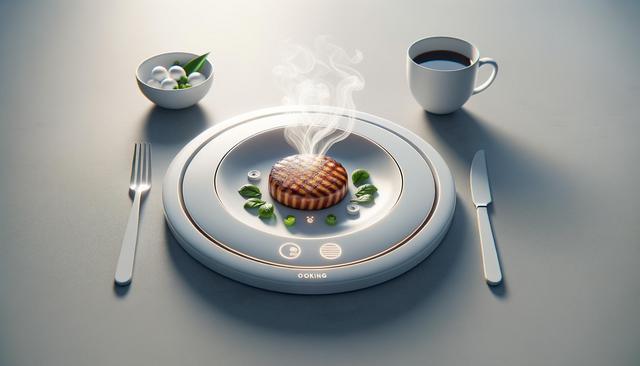Understanding the Self-Cooking Plate Concept
The concept of self-cooking dinner plates revolves around the integration of heating elements directly into the plate or its supporting structure. These innovations aim to eliminate the need for traditional kitchen appliances by allowing users to heat or cook meals directly on the serving dish. The foundation of this idea draws from existing technologies like self-heating meal containers, commonly used in military or emergency settings. These containers typically use a chemical reaction to generate heat and warm up pre-cooked meals. When applied to dinnerware, similar principles are being adapted, but with a focus on reusability, safety, and consumer convenience.
While the term “self-cooking” may suggest full meal preparation, most current prototypes or concepts focus on reheating or maintaining optimal food temperature. This makes the idea more plausible and aligns with ongoing developments in smart dinnerware with heating features. The goal is to create a seamless dining experience where food remains warm throughout the meal or can be heated without access to a stove or microwave.
Technological Innovations Driving the Possibility
Recent advances in materials science and electronics have given rise to innovative cooking plate technology. These include thin-film heating elements, temperature sensors, and battery or induction-based power systems. The integration of these components into ceramic or polymer plates is gradually moving from concept to prototype. Smart sensors can regulate temperature, preventing overheating and ensuring user safety. Some designs even incorporate wireless charging and app connectivity for greater control.
Researchers and self-cooking plate manufacturers are experimenting with various approaches to make the technology viable for everyday use. Key innovations include:
- Embedded heating coils that distribute heat evenly
- Rechargeable battery units for portable use
- Thermal insulation layers to prevent external heat transfer
- Food-safe materials that withstand repeated heating cycles
These features are essential for creating portable cooking dishes that are not only effective but also safe for regular use. As technology continues to evolve, the potential for self-heating dinnerware becomes increasingly attainable.
Market Trends and Consumer Demand
Interest in self-heating meal containers and similar technologies has seen a rise in recent years, fueled by busy lifestyles and the desire for convenient meal solutions. Market trends in self-heating plates indicate a growing appetite among consumers, especially in urban areas where space and time are limited. The portable cooking dish is becoming more than a novelty—it’s a solution for people on the go, students, campers, and professionals alike.
Factors driving this trend include:
- Increased demand for meal portability
- Rising popularity of meal prepping and on-the-go eating
- Technological advancements making products more accessible
- Environmental concerns encouraging reusable alternatives
Smart dinnerware with heating features fits into this narrative by offering reusable solutions that align with sustainability goals. As manufacturers continue to refine their designs, we are likely to see more consumer-ready options entering the market.
Challenges and Limitations
Despite the promising developments, several challenges need to be addressed before self-cooking plates become mainstream. One of the primary concerns is safety. Heating elements require careful insulation and failsafe mechanisms to prevent burns or fire hazards. Additionally, power source limitations—whether battery life or compatibility with induction chargers—can restrict the functionality of such plates.
Other notable challenges include:
- Cost of production and retail pricing
- Durability and lifespan of heating components
- Food safety regulations and certifications
- Cleaning and maintenance processes
Self-cooking plate manufacturers must also consider consumer habits. Traditional plates are typically easy to clean and store, while a heated plate introduces complexity. Balancing innovation with everyday practicality remains a key consideration in product development.
What the Future Holds
The future of innovative cooking plate technology depends heavily on continued research, investment, and consumer acceptance. Companies exploring this niche are focusing on making their products lighter, safer, and more energy-efficient. Partnerships with tech firms and material scientists are helping accelerate progress toward market-ready solutions.
As we look ahead, it’s likely that the first widely adopted versions of these products will lean more toward warming functionalities rather than full cooking capabilities. This incremental approach allows manufacturers to test consumer interest and refine usability. Advances in smart dinnerware with heating features may also lead to integration with smart home ecosystems, enabling users to control plate temperatures through voice commands or mobile apps.
In conclusion, while full self-cooking plates remain a work in progress, the innovations and market trends in self-heating plates suggest that we are not far from seeing advanced versions in everyday households. The blending of convenience, portability, and smart technology makes this a promising area to watch.
Conclusion: A Practical Future for Smart Dinnerware
For consumers interested in blending convenience with innovation, the evolution of self-heating meal containers and portable cooking dishes offers a glimpse into a more flexible and efficient dining experience. While the idea of a plate that fully cooks your food may still be evolving, smart dinnerware with heating features is already carving out a niche in the market. As self-cooking plate manufacturers continue addressing safety, usability, and cost, it’s reasonable to expect more refined options emerging in the near future. Whether for travel, work, or home use, these technologies reflect a broader shift toward multifunctional and user-friendly kitchen solutions.



Leave a Reply